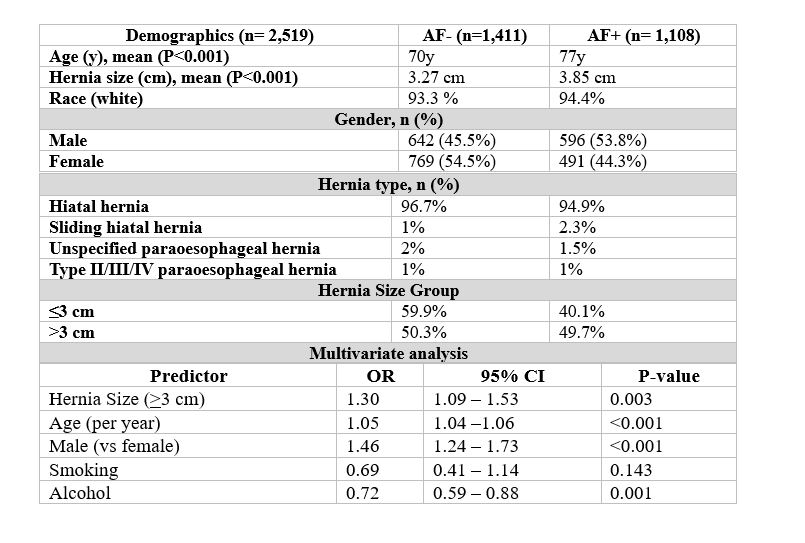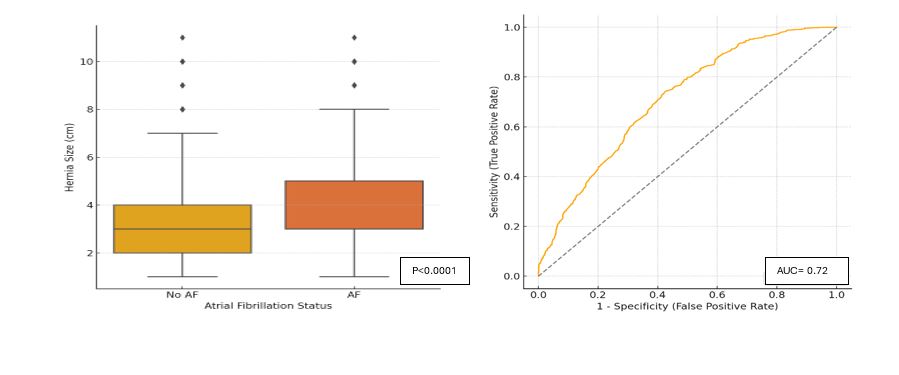Sunday Poster Session
Category: Esophagus
P0629 - Assessment of the Relationship Between Hiatal Hernia and Incident Atrial Fibrillation
Sunday, October 26, 2025
3:30 PM - 7:00 PM PDT
Location: Exhibit Hall

Ayah Matar, MD
Mayo Clinic
Rochester, MN
Presenting Author(s)
Award: ACG Presidential Poster Award
Ayah Matar, MD, Xiao Jing Wang, MD, Ravi Karthik, MD
Mayo Clinic, Rochester, MN
Introduction: Hiatal hernias result in protrusions of gastric mucosa into the thoracic cavity which can compress the left atrium. While this anatomical variation has been associated with increased frequency of atrial fibrillation (AF), little is known regarding the strength of the association of hiatal hernia and new onset AF. We aimed to investigate the association of hiatal hernias (HH) and incidence of new onset AF controlling for known risk factors and determine hernia size threshold associated with a significantly increased risk of developing AF.
Methods: Patients with a reported diagnosis of HH by endoscopy performed at a tertiary care center between 2020 to 2025 were identified from the clinical endoscopy database. The diagnosis of new onset AF diagnosis within a year of hernia documentation was then identified using ICD code. The association of hernia size and AF were evaluated using t-test. Multi-analysis variance was performed for large ( >3 cm) vs. small (< 3 cm) HH controlling for age, gender, alcohol and smoking. Logistic regression was performed to assess the predictive value of hernia size for incident AF adjusting for above risk factors.
Results: We identified 2,519 patients with HH on endoscopy of which 1,108 (44%) were diagnosed with AF within 1 year. Patient demographics, risk factors, and hernia characteristics are reported in Table 1. Patients with AF had larger HH than those without AF (mean 3.85 cm vs 3.27 cm, p < 0.001). Further, each additional cm increase in hernia size was associated with a 10.3% increase in the odds of AF (OR = 1.10, 95% CI: 1.06–1.15, p < 0.001). The presence of a hernia >3 cm was associated with a higher incidence of AF (49.7% vs 40.1%, p=0.0007). On multivariate analysis, hernia size >3 cm remained a risk factor (OR1.30; 1.09 – 1.53, p=0.003) along with age and gender. Logistical regression adjusting for factors mentioned, showed an AUC = 0.72, with a sensitivity 74% and specificity 57%.
Discussion: The presence of larger hiatal hernia is associated with an increase incidence of AF. Future studies assessing the therapeutic value of hiatal hernia repair in patients with AF are needed.

Figure: Table 1 showing demographics, hernia size and grouping as well as the different types across patients diagnosed with AF compared to patients without AF. AF: atrial fibrillation

Figure: Figure 1 showing (left panel) ROC curve for AF prediction while adjusted for age and gender, and (right panel) showing boxplot of hernia size in AF- group compared to AF+ group. Receiver operating characteristic (ROC) curve analysis was used to evaluate model performance, and the optimal threshold was identified using Youden’s index. AF: atrial fibrillation
Disclosures:
Ayah Matar indicated no relevant financial relationships.
Xiao Jing Wang indicated no relevant financial relationships.
Ravi Karthik indicated no relevant financial relationships.
Ayah Matar, MD, Xiao Jing Wang, MD, Ravi Karthik, MD. P0629 - Assessment of the Relationship Between Hiatal Hernia and Incident Atrial Fibrillation, ACG 2025 Annual Scientific Meeting Abstracts. Phoenix, AZ: American College of Gastroenterology.
Ayah Matar, MD, Xiao Jing Wang, MD, Ravi Karthik, MD
Mayo Clinic, Rochester, MN
Introduction: Hiatal hernias result in protrusions of gastric mucosa into the thoracic cavity which can compress the left atrium. While this anatomical variation has been associated with increased frequency of atrial fibrillation (AF), little is known regarding the strength of the association of hiatal hernia and new onset AF. We aimed to investigate the association of hiatal hernias (HH) and incidence of new onset AF controlling for known risk factors and determine hernia size threshold associated with a significantly increased risk of developing AF.
Methods: Patients with a reported diagnosis of HH by endoscopy performed at a tertiary care center between 2020 to 2025 were identified from the clinical endoscopy database. The diagnosis of new onset AF diagnosis within a year of hernia documentation was then identified using ICD code. The association of hernia size and AF were evaluated using t-test. Multi-analysis variance was performed for large ( >3 cm) vs. small (< 3 cm) HH controlling for age, gender, alcohol and smoking. Logistic regression was performed to assess the predictive value of hernia size for incident AF adjusting for above risk factors.
Results: We identified 2,519 patients with HH on endoscopy of which 1,108 (44%) were diagnosed with AF within 1 year. Patient demographics, risk factors, and hernia characteristics are reported in Table 1. Patients with AF had larger HH than those without AF (mean 3.85 cm vs 3.27 cm, p < 0.001). Further, each additional cm increase in hernia size was associated with a 10.3% increase in the odds of AF (OR = 1.10, 95% CI: 1.06–1.15, p < 0.001). The presence of a hernia >3 cm was associated with a higher incidence of AF (49.7% vs 40.1%, p=0.0007). On multivariate analysis, hernia size >3 cm remained a risk factor (OR1.30; 1.09 – 1.53, p=0.003) along with age and gender. Logistical regression adjusting for factors mentioned, showed an AUC = 0.72, with a sensitivity 74% and specificity 57%.
Discussion: The presence of larger hiatal hernia is associated with an increase incidence of AF. Future studies assessing the therapeutic value of hiatal hernia repair in patients with AF are needed.

Figure: Table 1 showing demographics, hernia size and grouping as well as the different types across patients diagnosed with AF compared to patients without AF. AF: atrial fibrillation

Figure: Figure 1 showing (left panel) ROC curve for AF prediction while adjusted for age and gender, and (right panel) showing boxplot of hernia size in AF- group compared to AF+ group. Receiver operating characteristic (ROC) curve analysis was used to evaluate model performance, and the optimal threshold was identified using Youden’s index. AF: atrial fibrillation
Disclosures:
Ayah Matar indicated no relevant financial relationships.
Xiao Jing Wang indicated no relevant financial relationships.
Ravi Karthik indicated no relevant financial relationships.
Ayah Matar, MD, Xiao Jing Wang, MD, Ravi Karthik, MD. P0629 - Assessment of the Relationship Between Hiatal Hernia and Incident Atrial Fibrillation, ACG 2025 Annual Scientific Meeting Abstracts. Phoenix, AZ: American College of Gastroenterology.

